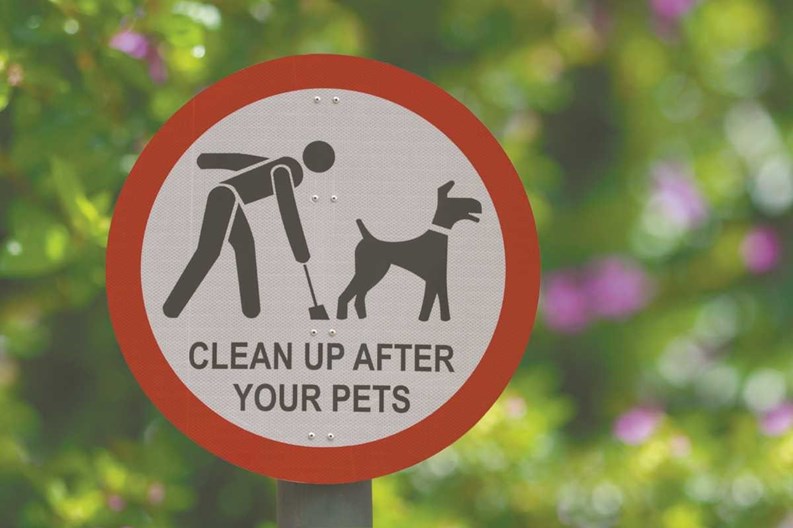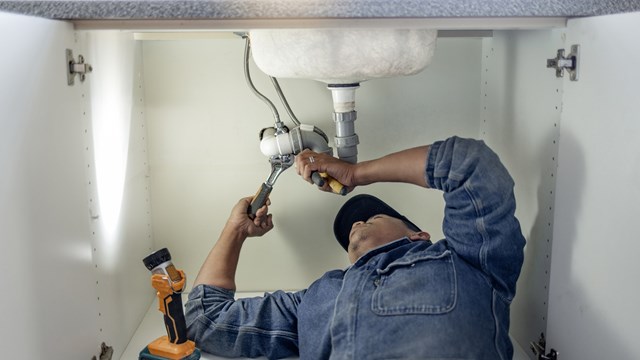The signs “Post No Bills,” “Active Driveway” and “Alternate Side Parking” are all fairly common and relatively self-explanatory in urban settings. Other equally common signs we see in suburban communities throughout the U.S. related to pets are: “Curb Your Dog,” “Please Clean Up After Your Dog,” or “All Pets Must Be on a Leash.”
Well, in South Florida it all depends on the town you live in and sadly, while the ordinance that deals with picking up after your pet varies little from neighborhood to neighborhood, the signage and cleanliness of the sidewalks certainly can and do vary. This variance in pet waste has to do with a few factors: The number of dog-friendly buildings in one area, proximity to green spaces and dog runs, and the all-important “responsibility quotient” of dog owners in the community. All it takes is for a few individuals to start the downward spiral of pet owners not picking up after their pets and it becomes a messy problem, so to speak, creating a rift between those who love animals and those who don’t.
While it may be hard for dog lovers to believe there are people out there who are either indifferent to or even have a dislike for dogs, it's important to respect the fact that they do indeed exist and as such, try to respect them while taking their dogs for a stroll or to do their “business” outing.
Pick It Up
When responsible owners take their dogs out to do their business, it’s a fairly routine process. Start with “curbing your dog.” This generally means bringing your dog to the curb to do their business. It’s a wonderful sentiment and actually works fairly often, but it is not foolproof. When curbing is not an option the next best thing is to (at least) guide them to a spot that is as out of the way as possible and hopefully they will do their “thing” there. Dogs, however, are no different than their owners in that when nature calls, nature calls and it is not always in the most convenient or inconspicuous spot. When this happens, the appropriate thing for the owner to do is clean up everything that is “removable” and continue on. Obviously, the irresponsible thing is to leave it there for some poor soul to step into.
There are some serious consequences to not picking up after your pet. Health hazards such as Campylobacteriosis, a bacterial infection that causes diarrhea in humans can be found in dog feces. Salmonellosis, the most common bacterial infection transmitted to humans from animals whose symptoms include fever, muscle aches, headaches and vomiting; and toxocarisis, roundworms that are transmitted from animals to humans also can be found in dog waste.
“Dogs eat a protein-based diet, it’s a toxic-based substance that needs to be taken out of the environment. There’s definitely a chance of bacteria in protein waste,” says Scott Chapman, owner of Scoop Da Poo, which serves the South Florida area. Some people mistake dog waste as manure. But cow dung can only be used as fertilizer because cows don’t have any meat in their diet. Dog feces can actually damage plant life because protein in the dog’s diet breaks down into a concentration of nitrogen, which burns lawns.
Another environment-based concern is bugs. “Dog waste attracts insects. Flies lay their eggs on it,” says Chapman. In most places in the country, more bugs are certainly a hindrance. But in Florida, the stakes are higher. Insects attract toads and frogs, and one of those toads is the poisonous bafu toad. “A dog bites it and it secretes a toxin, and the dog can die if you don’t catch it right away and hose their mouth out with a hose,” says Chapman. “If you can get it rinsed out yourself and it doesn't start having a seizure, you’re okay. But especially smaller dogs, because the same poison goes into a 15-pound body as opposed to an 80-pound body, I’ve known dogs that have died from it, little dogs,” he says. Chapman says his own dogs have bitten bafu toads on three separate occasions, and was able to act quickly to save them.
Other than neglect, some try to improperly rid themselves of the dog mess. “A lot of people will hose it down, get it in the grass, and the problem with that is that it gets in the soil, and then it gets in the water system, and it can contaminate the water system,” says Adrian Finch, owner of Poop 911 in South Florida. There’s simply no alternative to picking it up and throwing it away in the garbage. To deal with that reality, many buildings now feature pooper scooper stations. The stations provide bags for owners, and a garbage bin. Finch says the stations are one of the few ways to encourage people to pick up after their dogs, and it’s important to provide more than just a couple for large associations. “You have to put your bags in the right location. People are not going to walk 100 yards to get a doggie bag,” says Finch. “When people come home late at night, they're tired from a long day of work, or they've gone out, do they want to walk past three buildings to get a bag? Not really.”
To DNA or Not to DNA?
Unfortunately, that can often not be enough to rein in the poop problem. “The difficulty with a lot of buildings is the ability to identify or enforce the rule,” says Roberto Blanch, an attorney at Siegfried, Rivera, Lerner, De la Torre & Sobel, PA, in Coral Gables. “I've seen buildings set up hidden cameras, buildings also do things to promote the cleaning up by setting up the stations. And not too long ago we spoke with individuals with a company that actually have the dogs’ DNA checked,” says Blanch. The doggie DNA phenomenon is not just a reaction to watching too much “CSI: Miami.” Such services are sprouting up all over the country. A news report surfaced in January that officials at a downtown Orlando condo complex are going to start testing feces to find out who is not cleaning up after their dog. The Vue hired PooPrints, a Tennessee-based company that will take DNA samples from the HOA’s dogs, which are put into a global registry, and then will be used to track down owners when they don't pick up after their pets. The condo said it expects to have all the DNA samples collected during the month. Violators could face a $100 fine. A Plano, Texas apartment complex also hired the same company in January to test its resident pooches. They plan to fine violators $250 for non-compliance.The process is simple. One swab is “swooshed” around in the left cheek for 10 seconds, then one in the right cheek, and they are mailed into the lab and registered by use of a barcode. All owners—new and old—are required to register their dogs.
In theory, DNA testing eliminates any and all doubts about identity, as human criminal courts have demonstrated. But using the method for finding dog culprits and their owners can cause complications. “The challenge is the initial fee. It’s expensive initially. When you have renters, they come and go, and people say they have one dog when they have three,” says Finch. Companies often charge per dog for the testing service, so if a building has 100 dogs, the final bill can easily run into the thousands. Even if one dog is left out and the service finds no match, an owner could blame a dog from outside the community. Another problem can be compliance. Finch says some residents with multiple pets will lie about how many dogs they have in order to shirk fees and possible future fines. If any dog is left out in the DNA sampling, the process becomes much less effective.
For that reason, full cooperation from every resident is necessary for the DNA sampling, and it’s possible not everyone will welcome the new service. “You have to have 100 percent compliance in order for it to be 100 percent effective,” says Chapman. “I honestly don’t believe everyone would be willing to have their dog swiped for DNA. I don’t believe I would. I’m a responsible dog owner, and I feel like it’s a bit of an invasion. From a business standpoint, if I was going to offer that as a service I would think people would look more at me as the poop police as opposed to the really nice guy that comes around to do us a favor. I don’t want to attract any negativity to the industry,” says Chapman. Yet, the DNA testing is catching on, and reports show it’s largely worked. Finch says DNA testing or not, residents respond to the threat of fines. “They don’t want to pay,” he says.
Amidst all the accusatory drama, virtually every association contains residents with pets, and those without. Many times, people and board members without pets would love to solve the problem by simply banning pets altogether. But, Blanch says, Florida law does not make that easy. Even if you pass an amendment that bans pets or dogs from the building, often current dog owners can use a grandfather clause, which allows them to keep the animals. People are also finding more creative ways to get exceptions made for them. More and more people are getting notes from doctors that grant them the right to have an emotional support animal. “Over the last 10 years, I’ve seen it come from a very rare instance to the opposite. It’s rare if a building doesn’t have an owner who’s got a service animal. Then I think it begs the question: Is it worth it to have a building with a no-pet policy?” says Blanch.
For most people, dogs and other pets are just like family members. To most it seems like common courtesy, and a simple responsibility to clean up after your dog, but for now, associations should keep their eyes and noses open. Boards should make efforts to educate their residents so they’re aware of the environmental impact of neglected dog waste.
David Garry is a freelance writer and a frequent contributor to the South Florida Cooperator. Editorial Assistant Tom Lisi also contributed to this article.







2 Comments
Leave a Comment